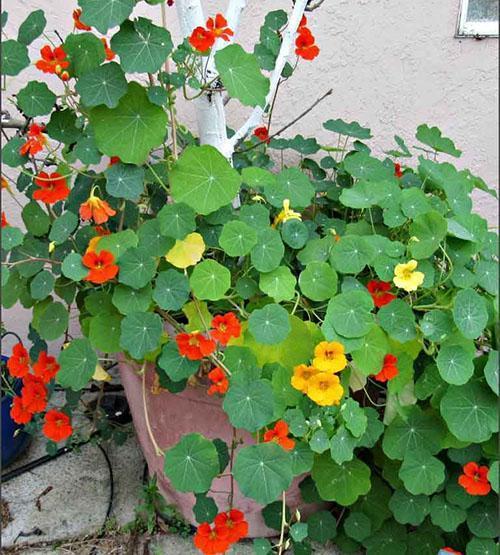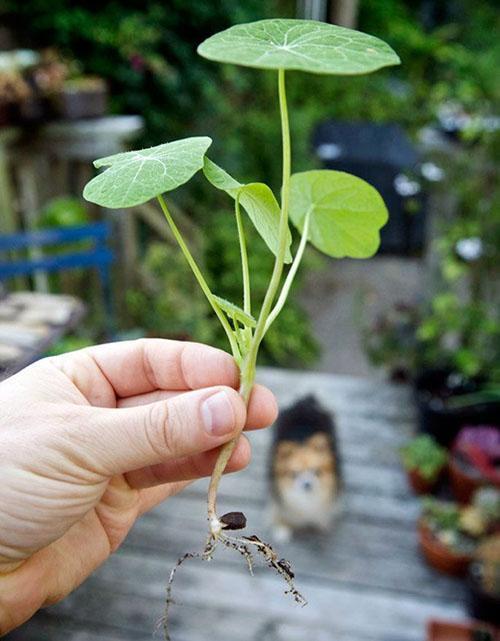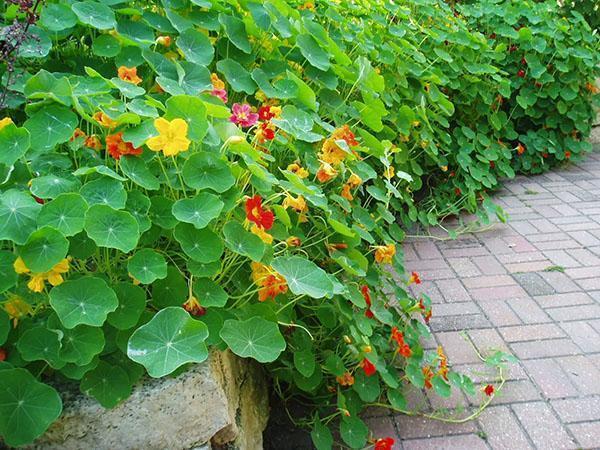To decorate the flower bed, we plant and care in the open field of nasturtium
 Climbing or bush nasturtiums are one of the most memorable flowering annuals, pleasing to the eye from the first half of summer until frost. If nasturtium has taken root on the site, planting and caring for it in the open field does not take a lot of time from the summer resident. The plant is unpretentious, responsive to care, blooms readily and abundantly. Experienced gardeners use nasturtium to protect their beds from pests, and gourmets know how to turn unripe seeds, young leaves and delicate flower corollas into an exquisite dish.
Climbing or bush nasturtiums are one of the most memorable flowering annuals, pleasing to the eye from the first half of summer until frost. If nasturtium has taken root on the site, planting and caring for it in the open field does not take a lot of time from the summer resident. The plant is unpretentious, responsive to care, blooms readily and abundantly. Experienced gardeners use nasturtium to protect their beds from pests, and gourmets know how to turn unripe seeds, young leaves and delicate flower corollas into an exquisite dish.
For several decades, nasturtiums disappeared from flower beds and front gardens, but today they are again finding admirers and worthy places in summer cottages, in parks, on terraces and loggias.
Dates of planting nasturtium in the ground in spring

In the middle lane, even the most frost-resistant varieties are not warm enough for wintering, so nasturtium is grown as a decorative summer plant, planted in the garden with seeds or seedlings.
How to organize the planting of nasturtium in open ground, when to plant flowers in different regions?
Nasturtium seeds begin to germinate when the air and soil warms up to 18–20 ° C. If the seedlings fall under frost, there is a danger of freezing, so they plan to plant nasturtium in the ground in the spring, paying attention to the weather conditions of the region. The further south, the earlier the right moment comes.
In the middle lane, seeds are embedded in open ground in the middle or at the end of May. In Siberia, where planting and caring for nasturtium in the open field is postponed for 7–10 days, for early flowering it is better to use not sowing in flower beds, but planting grown seedlings.
Planting in open ground with seeds and caring for nasturtium
 For nasturtiums, sunny, quiet areas with drained light soil are preferred. On poor soils, the plant looks depressed, its leaves shrink and brighten, flowers appear later and not as massively as on well-fertilized moist soils. At the same time, the culture has a negative attitude to the introduction of fresh organic matter.
For nasturtiums, sunny, quiet areas with drained light soil are preferred. On poor soils, the plant looks depressed, its leaves shrink and brighten, flowers appear later and not as massively as on well-fertilized moist soils. At the same time, the culture has a negative attitude to the introduction of fresh organic matter.
Dig up a place for sowing, carefully breaking up clods. The change is embedded in the soil to a depth of about 2 cm, and on lighter substrates, the holes are made somewhat deeper.
If planting nasturtium and care in the open field is complicated by the high density of the soil, it is better to add peat and sand to it in advance.
Furrows or holes for large seeds are made at a distance of 25 cm for bush varieties and with an interval of up to 40 cm for climbing, highly growing varieties. Experienced gardeners advise to sow 2-4 seeds in one hole. Curly nasturtium can quickly form a lush green crown for vertical gardening.
Fast-growing and luxuriantly flowering plants help to separate outbuildings from the yard in the shortest possible time, to plant trees in a gazebo or to create a comfortable shady corner in a sunny area.
When planting nasturtium and leaving in the open field, a trellis made of stretched cord or net helps to give the plant an upright position, to monitor the condition of the lashes.
After filling the ridges, the soil is slightly compacted and watered. Seedlings of nasturtium appear in 7-10 days.They are quite friendly and strong. So that the sprouts do not suffer from recurrent cold weather, they can be covered with non-woven material at night.
Taking care of nasturtium after planting outdoors
 Throughout the warm season, nasturtiums are watered, making sure that the soil under the plants is free of weeds and loose. From a lack of moisture, especially in hot weather, the casting of nasturtiums turns yellow, the buds fall off, and the already blossoming corollas fade faster. For irrigation, settled water heated in the sun is used.
Throughout the warm season, nasturtiums are watered, making sure that the soil under the plants is free of weeds and loose. From a lack of moisture, especially in hot weather, the casting of nasturtiums turns yellow, the buds fall off, and the already blossoming corollas fade faster. For irrigation, settled water heated in the sun is used.
Shrub nasturtiums bloom 25-30 days after sowing. Climbing varieties, regardless of the timing of planting and caring for nasturtium in the open field, open buds another 10-15 days later. To make the flowering lush and last until the first frost, the plants are fed monthly using complex mixtures. At the beginning of growth, fertilizers for nasturtium may have an increased concentration nitrogen and potassium. But then an excess of nitrogen causes a rapid build-up of green mass and a delay in the appearance of buds. Therefore, from June, top dressing should contain more phosphorus and potassium.
By autumn, the flowering of nasturtium gradually dies down, but does not stop. Therefore, green plants remain on the site until the cold weather.
Then the stems are harvested, the site is dug up and spilled with phytosporin or another means to improve the quality of the soil.
Planting nasturtium seeds for seedlings and caring for seedlings
 For those who do not want to wait for a whole month for the appearance of yellow, orange, white and red flowers of nasturtium in their flower beds, you can sow seeds in April and grow seedlings of this unpretentious flower at home.
For those who do not want to wait for a whole month for the appearance of yellow, orange, white and red flowers of nasturtium in their flower beds, you can sow seeds in April and grow seedlings of this unpretentious flower at home.
Sowing is carried out in peat pots to a depth of about 1 cm. This is important, since nasturtium does not tolerate transplanting well, and when planting, it is necessary to preserve both the earthen ball and all the roots formed.
After planting, the surface is compacted and watered. In the future, you need to moisten the soil regularly, preventing the entire volume of the pot from drying out. When the seeds hatch, the seedlings are provided with good light and temperatures in the order of 18–20 ° C. This will allow the nasturtium to form a sturdy plant with a few true leaves. The transfer of seedlings to a flower bed or to a balcony box is planned for May.
 And sowing with seeds, and planting nasturtium in open ground, and caring for an ornamental plant throughout the summer will not be able to complicate summer residents, even with the most modest experience. The flower is as unpretentious as it is decorative and useful. Bright clumps of nasturtium near cabbage beds will help distract aphids and cabbage butterflies. Potatoes and eggplant less attacked by the Colorado potato beetle.
And sowing with seeds, and planting nasturtium in open ground, and caring for an ornamental plant throughout the summer will not be able to complicate summer residents, even with the most modest experience. The flower is as unpretentious as it is decorative and useful. Bright clumps of nasturtium near cabbage beds will help distract aphids and cabbage butterflies. Potatoes and eggplant less attacked by the Colorado potato beetle.
 The unusual plant is used not only as an ornamental and phytosanitary culture. Irregularly shaped green nasturtium seed pods in the marinade acquire a spicy taste and are served as a snack. And flowers and leaves are a crunchy vitamin supplement for early low-calorie salads.
The unusual plant is used not only as an ornamental and phytosanitary culture. Irregularly shaped green nasturtium seed pods in the marinade acquire a spicy taste and are served as a snack. And flowers and leaves are a crunchy vitamin supplement for early low-calorie salads.